
The seven-day average of new daily cases of COVID-19 in Anderson County fell Tuesday, a reversal of a trend that had been in place since at least late June.
Still, the average number of new daily cases remained high, and it was higher than it has been in all but the previous week. And it’s not clear yet if the downward trend will continue.
The most recent seven-day average, in the week ending Tuesday, was 18.6 new COVID-19 cases per day. The highest it’s been, the week before, was 24.7. In late June, the county had an average of 3.43 new cases of COVID-19 per day.
Another trend that has reversed, at least for now: The number of active cases in the county fell four days in a row. It was 255 on Thursday. That was down more than 30 cases from a peak of 289 active cases on Sunday. Active cases are total cases minus recoveries and deaths.
In other potentially good news, the daily positivity rate, which measures the percentage of people who test positive for COVID-19 out of those who are tested, has fallen for at least two weeks.
The seven-day average of the positivity rate was 5.5 percent on Thursday. That was about 3 percent lower than the previous week and roughly 4 percent lower than two weeks earlier.
On Wednesday, the daily positivity rate was 2.9 percent. That’s the lowest it’s been since early July. It was higher again on Thursday, 5.6 percent.
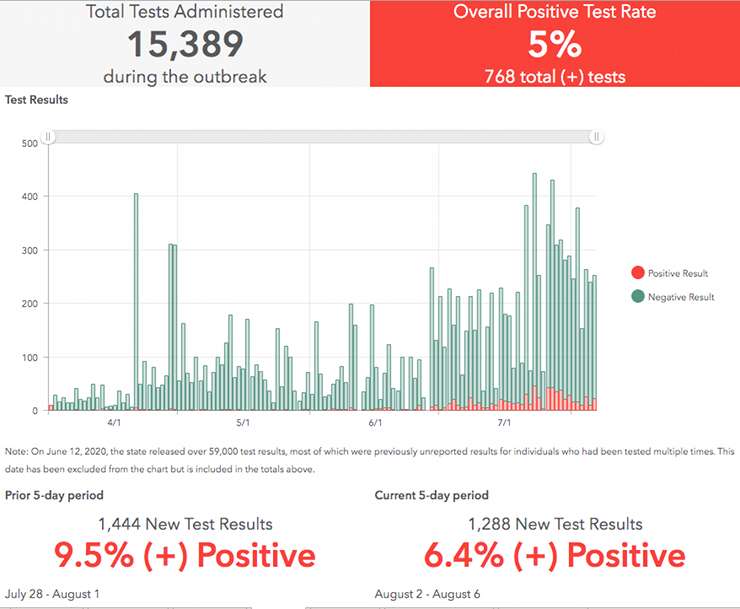
In the past month, the daily positivity rate peaked at 20 percent on July 14. It was at 10 percent or higher nine times in July. World Health Organization guidelines say positivity rates should be at 5 percent or lower for at least 14 days before activities re-open.
In Anderson County, the COVID-19 case doubling time has lengthened by several days, up to 16 days from 12-13 days a little more than week ago. That means the number of cases is not increasing as fast.
But there have continued to be hospitalizations and deaths due to COVID-19. Anderson County has had four more deaths due to COVID-19 in the past three weeks, and half of its 30 hospitalizations have been since July 15, or a little more than three weeks.
It’s not clear what led to the declines in the seven-day averages of new daily cases and the daily positivity rate, or whether those trends will continue.
It’s also not clear what impact a slower increase in new cases would have on new hospitalizations and deaths. Health officials and experts say there can be a lag of several weeks between changes in new cases and changes in new hospitalizations and deaths.
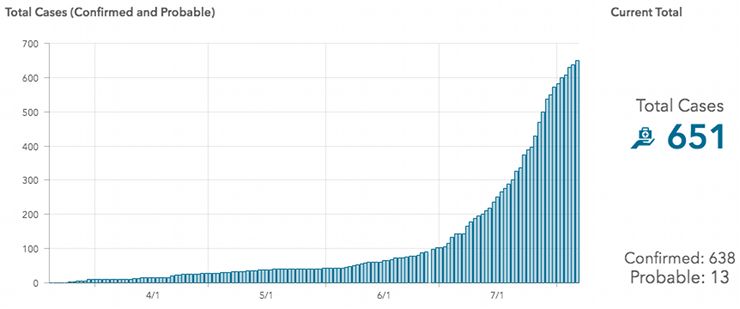
On Thursday, the Tennessee Department of Health reported that Anderson County has had 651 total COVID-19 cases since the first infection was reported on March 20. There have been six deaths due to COVID-19 and the 30 hospitalizations.
The number of COVID-19 cases has more than tripled since July 14 and has increased more than six times since July 2, when case growth seemed to accelerate in Anderson County.
Here are the recent seven-day averages of new daily COVID-19 cases in Anderson County calculated by Oak Ridge Today:
- Week ending June 30—3.43 new cases per day
- Week ending July 7—5.86
- Week ending July 14—10.86
- Week ending July 21—15.4
- Week ending July 28—24.7
- Week ending August 4—18.6
Here are recent seven-day averages of daily positivity rates:
- Week ending July 9—5.45 percent
- Week ending July 16—9.37
- Week ending July 23—9.6
- Week ending July 30—8.7
- Week ending August 6—5.5
Here are the COVID-19 numbers for Anderson County on Thursday, August 6:
- Total cases—651
- New cases—14
- Active cases—255
- Deaths—6
- Total hospitalizations (the number of current hospitalizations is not available)—30
- Recovered cases—390
- Total COVID-19 tests—15,389
- Daily positivity rate—5.6 percent
- Total positivity rate (comparing all cases to all tests since the pandemic began)—4.2 percent
- Transmission rate—1.04 (If the rate is greater than one, the number of new infections will increase.)
- Hospitalization rate—4.6 percent
- Fatality rate—0.9 percent
- Recovery rate—60 percent
- Case doubling time—16 days
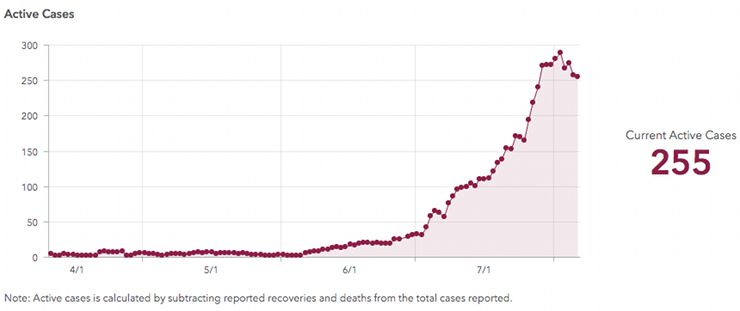
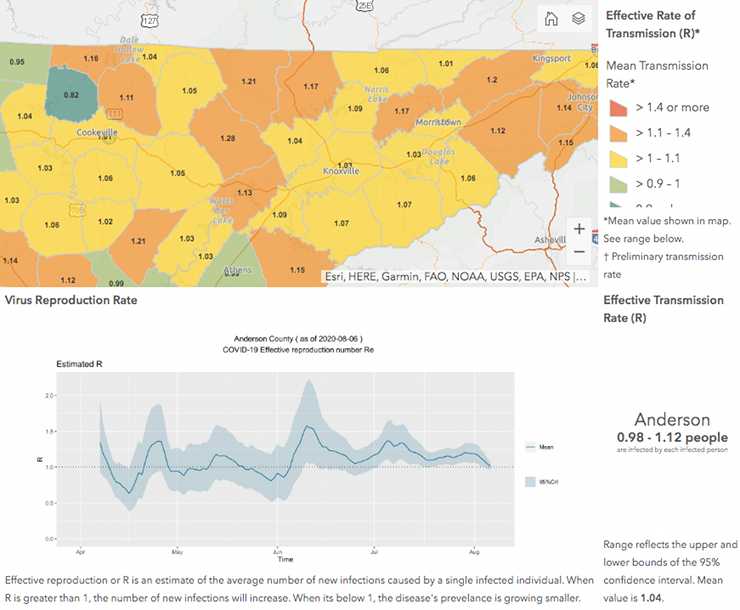
Here are the COVID-19 statistics for Tennessee on Thursday, as reported by the Tennessee Department of Health:
- Total cases—116,350
- New cases—2,252
- Active cases—37,606
- Deaths—1,186
- Death rate—1 percent
- Recoveries—77,558
- Recovery rate—66.7 percent
- Hospitalizations—5,109
- Hospitalization rate—4.4 percent
- Current hospitalizations: 1,082, with 324 pending
- Daily positivity rate—9.8 percent
- Total positivity rate—7.1 percent
- Average patient age—39
The first case of COVID-19 was diagnosed in Tennessee on Wednesday, March 4. Since then, there have been more than 1.6 million COVID-19 tests in Tennessee.
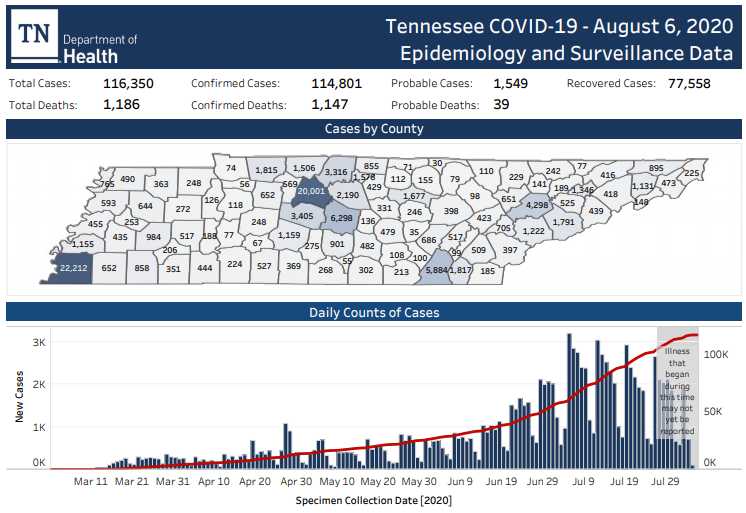
State, county statistics
The highest number of cases in the state is in Shelby County, which includes Memphis in West Tennessee. The case count there was 22,212 on Thursday, up more than 5,000 compared to July 21, about 2.5 weeks ago. There have been 300 deaths in Shelby County.
In Davidson County, 20,001 cases have been reported, an increase of more than 3,000 cases since July 21. In that county, 211 deaths have been reported. Davidson County includes Nashville in Middle Tennessee.
Other counties with case counts of more than 1,000 include:
- Rutherford (Nashville area), with 6,298 cases and 53 deaths;
- Hamilton (Chattanooga area), with 5,884 cases and 49 deaths;
- Knox (Knoxville area), with 4,298 cases, an increase of more than 1,700 cases in 2.5 weeks, and 37 deaths, about double the total on July 21;
- Williamson (Nashville area), with 3,405 cases and 25 deaths;
- Sumner (Nashville area), with 3,316 cases and 72 deaths;
- Wilson (Nashville area), with 2,190 cases and 23 deaths;
- Bradley (Cleveland area, near Chattanooga), with 1,817 cases and 12 deaths;
- Montgomery (Clarksville area), with 1,815 cases and 13 deaths;
- Sevier (Gatlinburg, Pigeon Forge, Sevierville), with 1,791 cases, up more than 600 cases in 2.5 weeks, and 6 deaths;
- Putnam (Cookeville area), with 1,677 cases and 16 deaths;
- Trousdale (Turner Trousdale Correctional Center), with 1,578 cases and 6 deaths;
- Robertson (east of Clarksville), with 1,506 cases and 19 deaths;
- Hamblen (Morristown area), with 1,346 cases and 14 deaths;
- Blount (Maryville area), with 1,222 cases and 9 deaths;
- Maury (Columbia area, south-southwest of Nashville), with 1,159 cases and 7 deaths;
- Tipton (Memphis area), with 1,155 cases and 7 deaths; and
- Washington (Johnson City area), with 1,131 cases and 2 deaths.
Here is COVID-19 case information about other counties besides Knox County that surround Anderson County:
- Loudon County has reported 705 cases, up more than 250 cases in 2.5 weeks, and three deaths.
- Roane County has reported 423 cases, more than double the total in 2.5 weeks and up about 270 cases since July 21, with two deaths.
- Campbell County has reported 229 cases, more than double the number of cases in 2.5 weeks, and one death.
- Union County has reported 141 cases, not quite triple the number of cases since July 21, with no deaths.
- Scott County has reported 110 cases, almost triple the number of cases in 2.5 weeks, with no deaths.
- Morgan County has reported 98 cases, about double the number of cases since July 21, with one death.
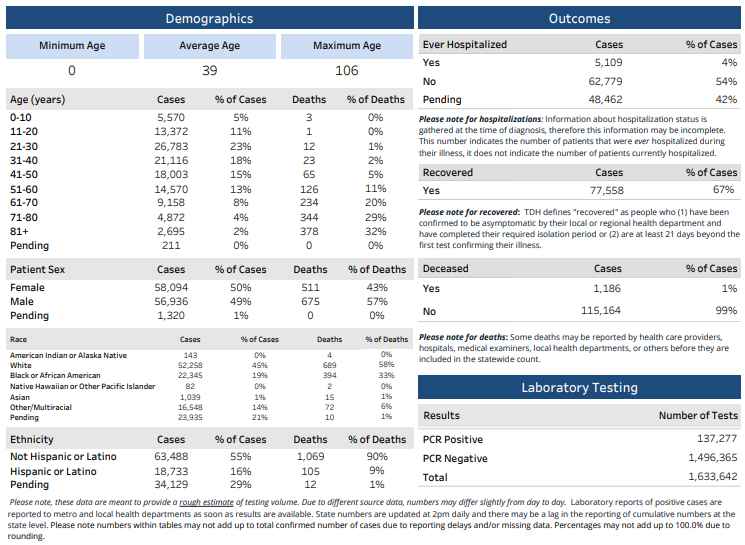
COVID-19 is a new, contagious respiratory illness that can be deadly. It can cause a range of health issues that can last weeks or months, including fevers, body aches, fatigue, coughing, and breathing problems, among other reported symptoms. The long-term effects remain unknown.
It can be spread by respiratory droplets from coughing, sneezing, talking, and singing. There is also debate about whether it might be spread by airborne transmission.
The disease appears to be especially deadly to older patients, according to data from the Tennessee Department of Health. There have been at least 10 deaths among all age groups 21 years old and older, and 65 or more deaths starting with the 41-50 age group. The number of deaths continues to climb in older age groups. There have been between 126 and 378 deaths in the four oldest age groups: 51-60, 61-70, 71-80, and 81 and older.
The largest number of cases continues to be among patients who are 21 to 30 years old, followed by patients who are 31 to 40, and then patients who are 41 to 50.
While some people report no symptoms or mild symptoms, others become seriously ill from COVID-19, sometimes for weeks, and the effects can sometimes last for months. Others are admitted to the hospital, and some patients end up in intensive care and on ventilators.
To help prevent the virus from spreading, officials have repeatedly recommended that residents wear a face mask or covering when they are out of the house and around others, maintain a distance of at least six feet from other people when possible, and wash their hands frequently.
See the state’s data here and here.
See the CORE-19 website here.
Leave a Reply